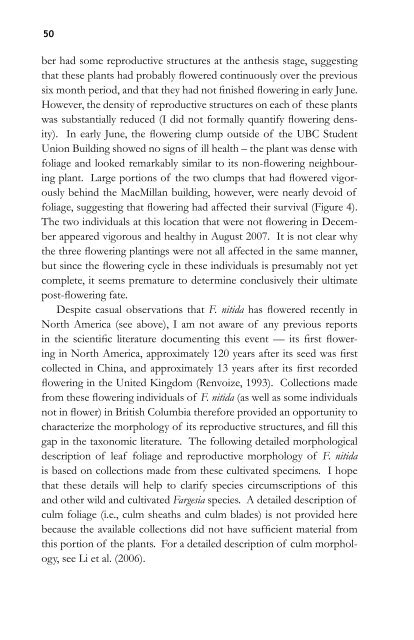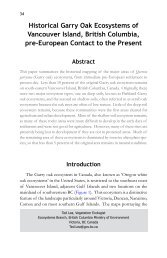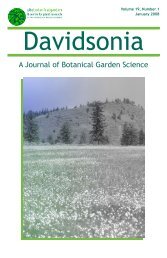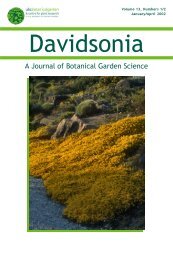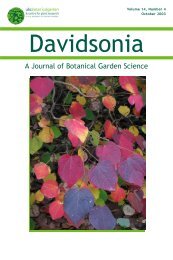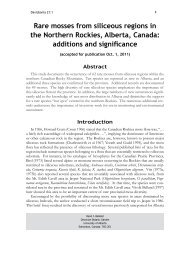in Vancouver, British Columbia, Canada - Davidsonia
in Vancouver, British Columbia, Canada - Davidsonia
in Vancouver, British Columbia, Canada - Davidsonia
Create successful ePaper yourself
Turn your PDF publications into a flip-book with our unique Google optimized e-Paper software.
50ber had some reproductive structures at the anthesis stage, suggest<strong>in</strong>gthat these plants had probably flowered cont<strong>in</strong>uously over the previoussix month period, and that they had not f<strong>in</strong>ished flower<strong>in</strong>g <strong>in</strong> early June.However, the density of reproductive structures on each of these plantswas substantially reduced (I did not formally quantify flower<strong>in</strong>g density).In early June, the flower<strong>in</strong>g clump outside of the UBC StudentUnion Build<strong>in</strong>g showed no signs of ill health – the plant was dense withfoliage and looked remarkably similar to its non-flower<strong>in</strong>g neighbour<strong>in</strong>gplant. Large portions of the two clumps that had flowered vigorouslybeh<strong>in</strong>d the MacMillan build<strong>in</strong>g, however, were nearly devoid offoliage, suggest<strong>in</strong>g that flower<strong>in</strong>g had affected their survival (Figure 4).The two <strong>in</strong>dividuals at this location that were not flower<strong>in</strong>g <strong>in</strong> Decemberappeared vigorous and healthy <strong>in</strong> August 2007. It is not clear whythe three flower<strong>in</strong>g plant<strong>in</strong>gs were not all affected <strong>in</strong> the same manner,but s<strong>in</strong>ce the flower<strong>in</strong>g cycle <strong>in</strong> these <strong>in</strong>dividuals is presumably not yetcomplete, it seems premature to determ<strong>in</strong>e conclusively their ultimatepost-flower<strong>in</strong>g fate.Despite casual observations that F. nitida has flowered recently <strong>in</strong>North America (see above), I am not aware of any previous reports<strong>in</strong> the scientific literature document<strong>in</strong>g this event — its first flower<strong>in</strong>g<strong>in</strong> North America, approximately 120 years after its seed was firstcollected <strong>in</strong> Ch<strong>in</strong>a, and approximately 13 years after its first recordedflower<strong>in</strong>g <strong>in</strong> the United K<strong>in</strong>gdom (Renvoize, 1993). Collections madefrom these flower<strong>in</strong>g <strong>in</strong>dividuals of F. nitida (as well as some <strong>in</strong>dividualsnot <strong>in</strong> flower) <strong>in</strong> <strong>British</strong> <strong>Columbia</strong> therefore provided an opportunity tocharacterize the morphology of its reproductive structures, and fill thisgap <strong>in</strong> the taxonomic literature. The follow<strong>in</strong>g detailed morphologicaldescription of leaf foliage and reproductive morphology of F. nitidais based on collections made from these cultivated specimens. I hopethat these details will help to clarify species circumscriptions of thisand other wild and cultivated Fargesia species. A detailed description ofculm foliage (i.e., culm sheaths and culm blades) is not provided herebecause the available collections did not have sufficient material fromthis portion of the plants. For a detailed description of culm morphology,see Li et al. (2006).


